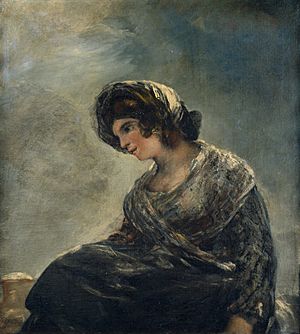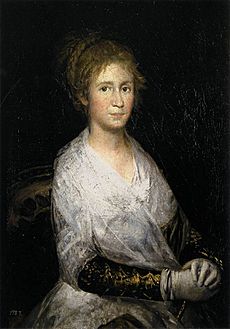La Leocadia facts for kids
Quick facts for kids La Leocadia |
|
|---|---|
| Spanish: Una manola: doña Leocadia Zorrilla | |
 |
|
| Artist | Francisco Goya |
| Year | c. 1819–1823 |
| Medium | Oil mural transferred to canvas |
| Dimensions | 145.7 cm × 129.4 cm (57.4 in × 50.9 in) |
| Location | Museo del Prado, Madrid |
La Leocadia (Spanish: Doña Leocadia) is a famous painting by the Spanish artist Francisco Goya. He finished it between 1819 and 1823. It is one of his 14 Black Paintings. The painting shows a woman often thought to be Goya's housekeeper and close friend, Leocadia Weiss. She wears a dark, traditional Spanish dress called a maja dress. She leans against what looks like a burial mound. Her expression is sad as she looks out at the viewer.
La Leocadia is one of the last Black Paintings. Goya painted these when he was in his seventies. At this time, he was dealing with many personal and political problems. He had moved to the countryside from Madrid. His friend Antonio Brugada made a list of Goya's paintings around 1828–1830. This list shows Leocadia was on the ground floor of Goya's home, Quinta del Sordo. All the Black Paintings were later moved from the walls to canvas. Today, you can see them at the Museo del Prado in Madrid.
Contents
Goya's Life and the Black Paintings
In 1819, Goya bought a small house called Quinta del Sordo. This means "Villa of the Deaf Man." It was located near Madrid by the Manzanares river. The house was named after its previous owner who was deaf. By chance, Goya himself had been deaf for over 20 years. This was due to an illness he had in 1792.
Goya was 73 years old and had survived two serious illnesses. He thought a lot about life and death. He was also upset by the Peninsular War that had affected Spain. He was also concerned about the Spanish Civil War of 1820–1823. During this time, Goya was also working on his series of prints called The Disasters of War.
Between 1819 and 1823, Goya painted 14 artworks directly onto the walls of his house. He used oil paints. At first, he decorated the rooms with brighter images. But over time, he painted over them with intense and dark pictures. These are now known as the Black Paintings. The portrait of Leocadia is one of them.
Goya did not create these paintings for public display. They were never meant to be seen by others. These pictures show his darkening mood. They depict scenes of conflict and sadness. Goya never gave titles to these works. The names we use today were given by others after he died. In 1824, Goya left Spain and the Quinta del Sordo. He moved to France. His housekeeper, Leocadia Weiss, and her daughter, Rosario, joined him there.
What the Painting Shows

The painting has a sad and quiet feeling. This comes from the gray background and Leocadia's black veil. Her traditional maja dress is also dark. Her expression looks sad or thoughtful. She stands in front of a bright blue sky. Her body leans slightly against a rock or mound.
The mound has small iron rails on top. Some art experts think it might be a burial mound. X-ray scans show that the mound might have been an open fireplace at first. The veil might have been added later. Leocadia's head rests on her arm. She looks thoughtfully towards the viewer. Goya shows her in a gentle way.
A yellow light shines on her face, arm, and chest. The background shows a blue and white sky. It has a yellowish light, like noon. This light reminds some of Goya's last works, like The Milkmaid of Bordeaux. This painting feels peaceful and calm. This is different from other works in the Black Paintings series. Some believe the painting shows the feeling of sadness. Others think it represents love and the idea of coming death.
Leocadia Weiss, Goya's Companion
The painting likely shows Leocadia Weiss (born Zorrilla, 1788–1856). She was Goya's housekeeper. She was 35 years younger than him. She was also a distant relative. However, some people question if it is truly her. Goya never titled any of the Black Paintings. He also never wrote about them.
Leocadia might have looked similar to Goya's first wife, Josefa Bayeu. One of Goya's well-known portraits is titled Josefa Bayeu (or Leocadia Weiss). This shows the confusion. While some say it is "more romantic" to think it's Leocadia, the painting looks a lot like another accepted portrait of her. That portrait was left to her after Goya's death.
Leocadia and her daughter Rosario lived with Goya. She took care of him after his wife died. She stayed with him at his Quinta del Sordo house until 1824. Around 1824, Goya became worried about the Spanish monarchy. He left Spain to live in France. Leocadia followed him with Rosario. She stayed with him until he died in 1828.
Not much is known about Leocadia. She was known to have a strong personality. She had a difficult marriage and separated from her husband in 1811. She had two children before that. Her third child, Rosario, was born in 1814. Rosario's father was not Leocadia's husband. Many have wondered if Goya was Rosario's father. People have also wondered if Goya and Leocadia were romantically involved. Some believe this painting shows her mourning Goya. Others think their friendship was simply very close and caring.
From her portraits, she seemed striking. She was likely in her early 30s when this painting was made. Goya's letters suggest her strong character sometimes upset him. Despite showing affection in letters, Goya did not leave Leocadia anything in his will. His son Javier inherited many of his father's paintings. Javier gave Leocadia 1,000 francs and some furniture. This was from the home she shared with Goya.
Leocadia wrote to Goya's friends to complain. She felt she was left out of the will. She also claimed Javier took things from her home. Sadly, many of Goya's friends were old and had passed away. Leocadia became very poor. She gave away her copy of the Caprichos prints. She also sold The Milkmaid of Bordeaux. Goya had told her not to sell it for less than "one ounce of gold." The price she received is not known. Her French pension was stopped soon after. She owned some of Goya's drawings. She sold them in 1849. Again, how much she received is unknown.
See also
 In Spanish: Una manola: doña Leocadia Zorrilla para niños
In Spanish: Una manola: doña Leocadia Zorrilla para niños



